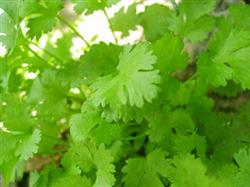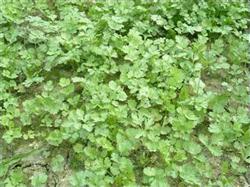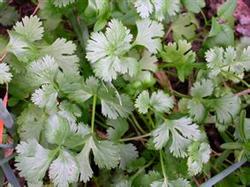Off-season cultivation techniques of coriander

The main results are as follows: 1. the varieties of coriander should be cultivated in summer and autumn, and the varieties of parsley which are resistant to damp and heat, disease, strong stress and big leaves should be selected. Second, it is difficult for coriander seeds to germinate at high temperature. Soak the seeds with carbendazim 300x wettable powder for half an hour before sowing, soak the seeds in clean cold water for about 20 hours, and then germinate under the condition of 20-25 ℃ before sowing. Third, soil preparation and fertilization should choose plots with convenient drainage and irrigation and loose and fertile soil, and the previous crop should be turned 20-25 cm deep in time after harvest and exposed to the sun for 15 days. In order to facilitate the use of the sunshade net, a deep trench high border with a width of 120 cm, a height of 20 cm and a width of 30 cm is made. Coriander growth period is relatively short, combined with soil preparation, per mu of rotten mature human feces and urine 3500 kg, cake fertilizer 150kg, calcium magnesium phosphate fertilizer 50kg as base fertilizer, to fine and level the surface soil of the border, in order to facilitate the emergence of seedlings. Fourth, timely sowing summer and autumn off-season cultivation of coriander, generally sowing from mid-May to early July, the seed consumption per mu is 1 kg, which can not only obtain higher yield, but also obtain higher price. In the case of suitable soil moisture, spread evenly and cover 1-2 cm. Cover the grass to protect the tide, protect the moisture and promote the seedlings, take it off after 5-7 days, and pay attention to maintain the soil moisture. Fifth, the summer and autumn atmosphere of field management is getting higher and higher, which will affect the growth of coriander, so take off the grass and cover the sunshade net in time. The sunshade net should be covered during the day and exposed at night to strengthen ventilation to prevent seedlings from growing thin and causing diseases. Because of the short growing period, coriander is suitable for early weeding, early seedling and early topdressing of available nitrogen fertilizer. Generally speaking, the seedlings should be carried out about 7 days after the full seedlings, and the seedlings should be fixed when there are 2 true leaves, and the seedling distance is 2-3 cm. Usually irrigate once every 8 days or so, start topdressing when the seedling is 3 cm high, topdressing 10-15 kg of urea and 250 g of boron fertilizer per mu. After that, combined with watering, carbon ammonia or urea was applied for 2-4 times, and in the later stage, appropriate amount of potassium dihydrogen phosphate should be added to promote leaf growth. Sixth, the prevention and control of diseases and insect pests of non-pollution parsley should be based on the principle of giving priority to prevention and supplemented by treatment, and a variety of control methods should be combined to control diseases and insect pests to a minimum. The main results are as follows: 1. Agricultural control is based on varieties with strong disease resistance, implement rotation and avoid continuous cropping. Timely removal of diseased plants and diseased leaves in the field to reduce the chance of bacterial infection. Strengthen fertilizer and water management and improve plant disease resistance. 2. Physical and biological control techniques such as frequency vibrating insecticidal lamp, sex attractant, Bt powder and so on. 3. Chemical control diseases mainly include seedling quenching disease, adult stage virus disease, anthracnose and spot blight. Five days after emergence, spray once with the 800-fold solution of pollution-free fungicide 3% polyoxane, and then spray 600 times every 7 days for a total of 2-3 times, which can prevent quenching, anthracnose and spot blight. To prevent and control virus diseases, anti-insect nets can be used to prevent the spread of aphids from flying in; shading can be used to avoid high temperature and drought environment to reduce the occurrence of aphids; and 20% imidacloprid wettable powder 20 grams plus 50 kg of water can be sprayed on leaves to thoroughly control aphids and prevent the occurrence of virus diseases. Liriomyza huidobrensis was sprayed with 1500 times of avermectin. About 40 days after harvest and sowing, it can be harvested. Spraying 20-25ppm gibberellin about 15 days before harvest could elongate leaves, increase branches and increase yield.
- Prev

Management and Technical methods of coriander after the Beginning of Autumn
Characteristic description and control methods are often found in low-lying and moist land. After the incidence of coriander root system, the main root is yellowish brown or brown, soft rot, no or almost no fibrous root, the root system of the plant is broken as soon as it is pulled out by hand, the aboveground plant is short, and the leaves are withered and yellow. lose its commerciality. The prevention and cure method is to avoid as low as possible.
- Next

Common diseases and control methods of coriander
As a seasoning vegetable, coriander is rich in nutrition and simple in cultivation and management. the key techniques of coriander cultivation are introduced as follows: coriander belongs to Umbelliferae. It can withstand the low temperature of-1 ℃ to 2 ℃, and the suitable growth temperature is from 17 ℃ to 20 ℃. It grows slowly when it exceeds 20 ℃, and stops growing when it is 30 ℃. Coriander to soil.
Related
- Where is it suitable to grow horseradish in China? it is expected to see the middle altitude horseradish in Alishan.
- How to prevent tomato virus disease reasonably? (Control methods included)
- Many people like to plant towel gourd on the balcony. What are the main points of this method and management?
- What crops can chili peppers be mixed with?
- Fertilization techniques and matters needing attention in Tomato
- What are the grafting techniques for peach seedlings in spring?
- Harm and control methods of root swelling disease of Chinese cabbage
- What are the pests of sweet potatoes? How to prevent and cure it?
- Symptoms, causes and Control methods of navel Rot in Tomato
- The cause of "Cucumber rotten bibcock" in Farmers' planting Cucumber and its Control Plan

